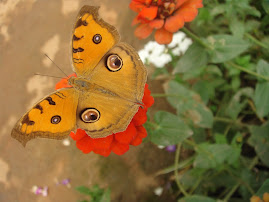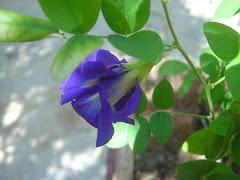
There are countless varieties of Colocasia in our region. But this one
pictured above with droplets of rain, happens to be my favourite. Why?
Because this variety does not cause any irritation or burning of the
tongue and throat. If not cooked properly, consuming other cultivars
can be a most unpleasant experience.
Locally known as Neel kosu, it grows to a height of 5 ft. or so. The
stems are a deep purple. It does well in full sun too but mine has
partial shade. A south-east Asian native, this is a popular vegetable.

Edible and non-edible varieties grow side by side. Ignore the haphazard
planting, and the weeds!!


The stems can be made into a delicious dish, after chopping them
into smaller pieces. I usually cook with green chillies, onions,
garlic, coriander, salt, tomatoes,cumin, and ginger paste. My
favourite garnish? Chopped culantro/serrated coraiander.


The leaves can be fried in a batter of chick-pea or gram flour. I
made some today and they vanished in a jiffy! Rice flour also
works out well. You need to make a batter with the flour and
add salt, chilli powder, coriander and cumin powder. You can add
more masala (spices) but even with these basics, they taste good.
Remove the hard portion from the centre of the leaf and cut it into
two or four pieces, depending on the size of the leaf. Rub the batter
on the inverted side and fold as shown in the photo. Secure with a
toothpick. Dip the folded leaves in the batter and shallow fry in oil.

Embellishments, in order to enhance the look of a particular dish
may be attractive, but sometimes they take away the attention from
the main object of discussion. Keeping that in mind, there's no
garnish here. Just the folded leaf, fried to a golden brown.













































.jpg)

































18 comments:
Hello Kanak,
Your finished dish looks delicious and this plant is beautiful in the landscape.
Well I learned something new - I have never heard of this plant. It's pretty in the garden and the completed dish looks very tasty. Are you able to preserve it for future use or do you only use it fresh?
Kanak we cook with that too and we call it callaloo. Iti s cooked with crab and it is the national dish of Trinidad and Tobago. That looks delicious. Here is the link for callaloo http://www.simplytrinicooking.com/search/label/callaloo
I never knew you could cook this plant Kanak. I'll just have to take your word on how it tastes.
You really do have the most interesting things on your blog my friend.
I confess I have never heard of this plant Kanak but the recipe sounds like it could be delicious and as you mention that it disappeared in a jiffy it obviously is!
Regarding your white mystery plant, the one in my garden which I was trying to think of is a Tradescantia, however I am not completely sure it is the same as yours.
I too have the plant, which I brought from Orissa. But I have suddenly become highly allergic to the leaves. So my friends usually take away the leaves to make that mouth watering 'Patrode", which I can't eat. Happy eating!
Awesome! I'm going to try this. I usually do a similar preparation with spinach.
Looks delish. Your dish is called saheena in Trinidad. People also chop the leaves and mix it with the batter, dropping heaped tablespoons of the mixture in the hot oil.
We cook the colocasia or dasheen leaves in many ways-my favorite is like a spinach-where is cooked down to a smooth paste that's eaten with chappatis.
Noelle, thanks. There are so many kinds here that marshy areas are filled with the greener ones. They simply grow wild.
Mildred, I think it can be preserved. But we always have them freshly made.
Helen, so glad to hear this! I'll surely check out the site and try out the island variation too!!
Oh, Susie....how nice of you to say that! It's just that you have to know the varieties that are edible.
Jan, thanks for your comment on my post. I'll check out Tradescantia. Thanks for stopping by again and telling me about it.
Padma, thanks! Too bad about the allergy! Hope you'll be able to enjoy having 'patrode' in the future!
Urban Green, I haven't tried the spinach version. Thanks for sharing.
Nicole...I'm so glad I posted on this! Thank you for the inputs. The sarson-ka-saag way sounds great! Will try out the pakoda version with the leaves. I'm taking for granted that you understand the Hindi terms:-)
Yes, I am back again, Kanak, and not every blogger has the ability to engage a reader enough to make him or her visit again. So, another lovely day of reading your diary. You wear so many hats, Kanan. Is there a book coming soon? Seriously, it's an ace blog you share with us. Thank you so much, Kanak. The rest is for our "talk". :) - Pami :)
Wow! Too bad I wouldn't be able to single out this colocasia. We have lots of them here. I would love to know the taste. I think I would like the leaf better (the fried one);-) Does it taste like spinach at all or any green leaf vege? Happy cooking and gardening!
Dear Kanak
That's really tempting, we also cook these leaves (taro leaves aka Kachalu leaves) making patrodas, but i think i'll give this receipe a try.
I love both the leaves and the root vegetable too.
Wow, that sounds fantastic! What a lovely meal and so mnay ideas!Love the photos and the whole look of the plant and leaves..amazing! I always love learning abut new plants and foods..so thankyou for introducing this to me! Wonderful!Whoever gets invited to your dinner table is very lucky!!
I honestly do not know that colocasia can be eaten. Are all colocasia edible or only some types that can be eaten? This dish looks very delicious.
Oh I am very allergic to this! I ate once and almost choked myself to death :D Never been near one since then. Though I like the taste. It causes swelling of my throat. And it takes anti allergic to subside it.
Pami...welcome back! And thank you once again for your kind words. No book, nothing like that!! When I first started blogging, I thought I'd include a lot of recipes. But my passion for all kinds of winged creatures has given me so much joy that cooking "postable" food has taken a back seat. But if responses are like this, I should include more recipes:) I'll get in touch with you.
Steph, I thought it was very common there too! No, not all are edible. But this one is fine. Other edible ones need to be blanched before cooking. And something sour like lemon juice has to be added to the preparation.
The leaves taste as good as other leafy veggies.
Zindagi, thanks for telling me about patrodas. I like the root too. There are so many variations in cooking the same dish. Isn't that interesting?
Kiki....thanks! I don't think I deserve all that!! If you found the photos appetising, then I'm happy. I love to read about different kinds of food too. Even if I don't cook all kinds, I still like to read recipes.
Autumn Belle, there are some which are not edible. Here, the ones sold in the markets are all safe so we don't have to worry. But I still prefer to have my few home-grown ones...fresh from the garden.
Chaitra, Lotusleaf (Padma) also wrote in her comment that she's allergic to this! Sorry to hear that! Too bad!
Hi Kanak. Interesting post, I have many colocasia plants. Do you prepare the tuber for eating as well?
Prospero, thanks! Yes, we have the tuber too. Delicious! And in a variety of ways. Maybe I should post on this also:-)
Post a Comment